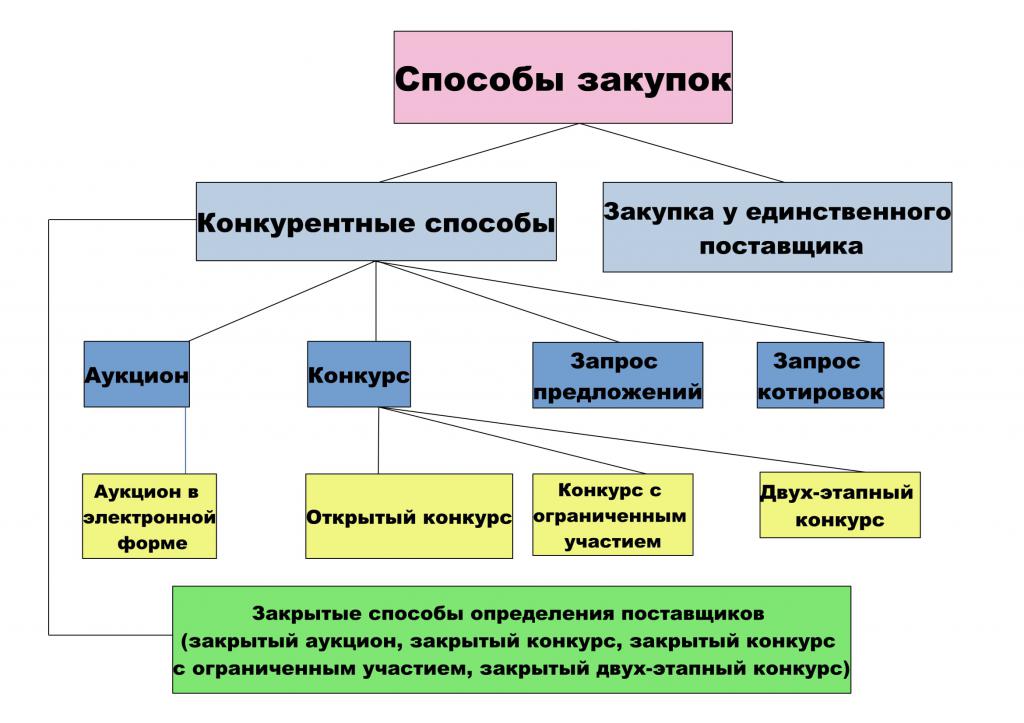With the introduction in 2014 of federal law No. 44-FZ, new methods and rules for bidding were approved. The procurement process is described in it at all separate levels - the formation, placement and subsequent management of the execution of the order. In this article, we consider what procurement methods and their characteristics exist.
Principles
First of all, customers should be guided by the principles of procurement - it is they who determine the state policy in this industry and their direction.
The principle of openness, transparency reflected in providing complete and accessible information. A tool for implementing this principle can be called a single information system (EIS) - the main procurement portal. It can accommodate not only tenders, but also other data - schedules, results of monitoring and audit of procurements, etc.
Competition how the procurement principle is aimed at providing equal rights to all market participants. For example, it is unacceptable to use trademarks without the words "or equivalent" in the terms of reference - this leads to a decrease in the number of participants, therefore, the principle of competition is not fulfilled.
Stimulating innovation. The law on the contract system does not indicate what is included in the concept of "innovative product". However, for commercial procurement, it was found that innovative products or services received as a result of scientific research, technological work with improved characteristics are considered innovative.
Unity principle defines equal approaches for planning and monitoring the procurement of state-owned enterprises throughout the country, regardless of their field of activity.
Professionalism - ensuring the procurement of qualified employees, regular training in the procurement industry.
Responsibility Responsibility - the degree to which the customer has achieved the plans and their high efficiency as a ratio of the result obtained with the resources spent.
Procurement list
State or municipal enterprises procure for a variety of needs. This may be the delivery of goods (stationery, food, medicine, household items) or the provision of a service or work (repair, construction, Internet network and much more).
To find suppliers, the company conducts tenders or, as they call purchases or tenders. According to federal law No. 44-FZ, they can be divided into two main types. These are competitive ways of purchasing and purchasing from a single supplier. Competitive divided into:
- contests (open or closed, with limited participation and two-stage);
- auctions (electronic, closed);
- requests for proposals;
- requests for quotes.
The determination of the procurement method is selected by the customer. This is done depending on the costs of conducting and the benefits received. For illustrative information, we present the methods of procurement in the form of the diagram shown.

Auction
The method for determining suppliers through open auctions and tenders is indicated in the second chapter of Law No. 44-FZ. A method of purchasing an auction is one of the most common methods. Most of all tenders are carried out on them - about 54% of the purchases. In the next place are purchases from sole suppliers or contractors, and in the third - open tenders. Through an auction, you can place purchases both for the supply of goods, and for the performance of work and services.
Auctions as electronic procurement methods are placed and held on trading floors on the Internet. Under the procurement law, five electronic sites are provided for this.To submit an application for an electronic auction, you do not need to send documents in writing - just attach them to the application in electronic form.
The application of the participant is formed of two parts. In one part, the consent of the participant is included, in which he confirms that he is ready to fulfill the conditions on the subject of the contract - delivery, work or service. Also here, the participant informs about the specific characteristics of the delivered goods.
In part two, all the detailed information is already provided to the participants: statutory documents, licenses for the field of activity, papers on compliance with the requirements, as well as documents by which the participant will have advantages during the consideration of applications.

The government approved a list of objects for the purchase of which customers must necessarily conduct tenders in the form of an auction in electronic form. For example, if this:
- goods - clothing, products, paper and paper products, medicines;
- services - water transport, water disposal, car repair;
- works - erection of buildings, cleaning, washing windows, services of tourist enterprises and others.
In addition, an auction is held if it is prohibited by law to make purchases through a single supplier or through a quotation announcement. A notice of electronic bidding is also posted if additional criteria are not necessary for the required product or service: experience, qualifications, and applications from participants can be considered only by the criterion of “contract value”.
Open competition

The difference between the auction and the competition is that the participant who has offered the lowest contract price is considered to be the winner in the auction. There are slightly different criteria in the competition - the participant with the best conditions wins. Consideration of applications for tenders is carried out by a commission - competitive or auction.
The competition and its stages are described in detail in Articles 48-55 of Law No. 44-FZ. An open tender is placed for all suppliers on the official procurement portal - a single information system (UIS). When the competition is announced, a notice and documentation are posted. The requirements for all participants are the same. The winner is determined during the consideration of applications according to all criteria specified in the documentation.
Competition as a competitive method of procurement is divided into subspecies:
- with limited participation;
- 2-stage.
Consider these subspecies in more detail.
Limited Competition

Features of this method of procurement of goods (or services) are specified in article 56 of the federal law governing procurement. In a competition with a limited circle of persons, uniform and additional requirements are presented. However, only persons who have passed prequalification screening or selection (FFP) are allowed to participate. In what cases should customers choose bidding with limited participation? They are as follows:
- If the subject of procurement is the supply or implementation of innovative and high-tech facilities. Note: this list is established by the Government.
- If the subject of purchase is an object of culture, museum objects and collections, as well as everything related to archival documentation, storage, restoration and library collections.
Two-stage competition
The competition with two stages differs from the usual open competition in that applications are submitted twice. First, suppliers offer their terms on the subject of bidding without the cost of the contract. Then, at the next stage, after discussing the preliminary application, the final one is provided. It indicates the value of the contract, as well as the specified conditions of the supplier. This method of procurement is carried out when these requirements are met:
- Purchase is carried out for scientific works - research, projects, including architectural, as well as for the creation of intellectual works - literature, art (Article 57).
- It is necessary to discuss with the participants the characteristics or parameters of the procurement item.
If the buyer in the process of writing a description of the procurement object must clarify certain criteria or choose the correct wording of the name of the procurement, he discusses these issues directly with suppliers. These clarifications are taken into account at the initial stage - in the formation of the technical specifications.
Request for Proposals

This bidding procedure was introduced in 2014, with the entry into force of the new procurement law 44-FZ. Despite the relative novelty of this procurement method and the lack of clear regulation, many customers increasingly use it in determining suppliers.
Request for proposals is sent in writing from the customer to suppliers or contractors. The request indicates all the necessary requirements and criteria for the subject of procurement.
The federal law (Article 83) states that in the request for proposals, the winner is the participant who sent the best offer for a product or service that meets the requirements specified by the customer.
In practice, this procurement method is used when, during the review, the auction or tender was declared invalid due to the lack of applications, participants' non-compliance with requirements, or for other reasons.
Request for quotes
During the quotation, a notice is also posted to an unlimited number of persons. The winner is the participant who offered the lowest cost of the contract. It should be noted that the initial price for a quote cannot be more than 500 thousand rubles. And the annual volume at the request of quotations should not exceed ten percent. These requirements, specified in article 72 of the federal law, must be taken into account when planning annual plans and methods of public procurement.
Pros of quotes:
- The speed of the procedure among other competitive methods.
- The process of quoting is quite simple, strictly defined and a small list of documents is required. Therefore, the risk of receiving complaints from the FAS, the prosecutor's office and other control bodies is minimal.
- In the applications of suppliers, one can consider not only cost criteria, but also others - for example, operating costs, functional characteristics, etc.
The cons of quotes include:
- You can not consider the lots separately.
- To participate in the quote, you do not need to secure the application, which is usually used in competitions or auctions. In this regard, unscrupulous suppliers may be allowed to bid.
- Great responsibility in relation to the participants - registration of applications, ensuring confidentiality.
- Control and oversight bodies can verify the validity of this method, since quotes have set limits on volumes and amounts.
Typically, a quotation request is announced when you need to supply a simple product in small quantities, which does not require high qualifications from the supplier.
Trades through a single supplier

This type of tendering accounts for about 20% of purchases of state customers. The method of purchasing from a single supplier is not competitive, that is, the contract is concluded directly, without considering applications.
By the way, this purchase is more a right than an obligation. The advantage of tenders with one supplier or contractor is their relative ease and economy in time. They are carried out with a small amount under the contract or if the purchase is not regulated by any restrictions, complex criteria.
In chapter 6 of the law, in article 93 as amended, 54 cases are indicated when it is possible to conduct a tender through a sole contractor. Listing them in this article is perhaps pointless.
We list the main circumstances in which it is possible to purchase goods or services from one supplier:
- the purchase did not take place;
- procurement in the construction industry - purchase, rental, repair, etc.
- bidding in the fields of culture, scientific and educational spheres, sports;
- medical support, including emergency situations;
- procurement of public services for buildings - electricity, heat supply;
- suppliers are natural monopolists, that is, they are not replaced and have no competitors (water supply or rail transport);
- in the field of defense and state protection;
- others, which provide for the purchase from one supplier.
In addition to the above, you can add small purchases in the amount of not more than one hundred thousand from one contractor selected by customers for the delivery of goods - equipment, office equipment or services - for example, for rental of premises. As for the annual volume, tenders should not be more than two million, or, if the enterprise is large, more than 5% of the total procurement rate and not exceed 50 million rubles (article 93 of federal law 44-FZ).
Closed Bidding

What are the methods of purchasing a closed method? It is worth noting that only auctions and competitions are classified as closed. In accordance with Section 84 of the Law, the procedure for conducting such tenders is determined by the fact that customers send invitations to participants, that is, if an unlimited number of persons can participate in open forms, only invited suppliers participate in closed tenders.
Closed bidding is held in four cases regulated by law:
- Procurement is carried out to provide federal authorities, and if information about these needs is a state secret.
- The procurement of goods, services and works is a state secret and their information is reflected in the auction / tender documentation or in the draft state contract.
- If the subject of procurement is insurance and protection, relocation of objects of the Fund of Precious Metals and Stones of Russia or museums, archival documents (including copies), manuscripts and other objects of cultural and historical significance. Also, if these items are transferred and accepted by customers for temporary use / possession of individuals or legal entities, including the holding of exhibition events in Russia or abroad.
- When bidding for cleaning buildings / premises, as well as providing services as a driver for judges and bailiffs.
Closed purchases are not placed in a single information system, but are sent to a limited number of persons with an invitation to participate.
During the closed competition it is not allowed to send electronic information: requests for documentation and answers to them, amendments made, documents on the competition. Explanations regarding the provisions of the documentation are sent to all participants in paper form, which indicates the subject of the request, but without indicating the person who sent it. The protocol on the results of such tenders is not published in the media and on the main procurement portal. Also, audio and video recording is not allowed during the competition.
Conclusion
So, the methods of procurement include auctions, tenders, quotes, requests for proposals and purchases with a single supplier / contractor. Competitions are also divided into open / closed, two-stage and with a limited circle of persons. Determining the procurement method is an important point in planning annual schedules.
In accordance with the law on the contract system, public procurement can be classified on a competitive basis or directly with one supplier, without such procedures.
Also, purchases can be divided into closed and open. Closed include competitions and auctions. To participate, suppliers must receive an invitation from customers. Information from such purchases was not disclosed. Consequently, open procurement is available to an unlimited number of people. A mandatory requirement for all those involved is common requirements: the absence of debts on taxes and fees, administrative responsibility, conflicts of interest, they also should not be an offshore company and so on.These requirements are specified in article 31 of the law.
